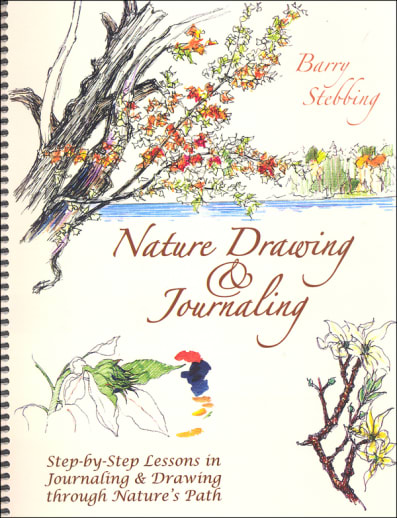If you can train yourself in the habit, keeping a nature journal offers not only the opportunity to continually hone artistic skills, but also provides ample opportunities to enjoy the outdoors, develop a deeper appreciation for nature, enhance penmanship and writing abilities and become a precious keepsake for years to come. This guide takes students lesson-by-lesson through developing their own nature journal and building the skills they'll need to capture examples of nature's beauty. Created by Barry Stebbing, author of the How Great Thou Art courses, these lessons are formatted similarly with short, easy-to-read lessons and a related assignment. There are 47 lessons total, the first segment focusing on assignments that can be done in the classroom, and later assignments which students will get to head outdoors to do. Lessons include designing the journal cover; learning how to appropriately frame the page; creating various tones in green and brown, and drawing specific objects or scenes such as onions, vines or tree trunks, landscapes, night scenes, farm animals, feathers, insects and much more. The lessons are illustrated with a variety of related drawings (both color and black-and-white) by Barry, some of which serve as examples to copy, and others to provide inspiration or examples for students' own drawing. The last piece of the book provides several blank journal pages with lines, a space for an inspiring quote and blank areas for drawing. You'll need a few specific supplies to complete the lessons, including a hardbound journal, a legal pad, a rubber band, colored pencils, a drawing pen, a writing pen, glue stick, tape, washable markers, a #6 watercolor brush (to use with the markers) and semi-gloss paper. Especially if you're not already emphasizing art in your curriculum, a course in nature journaling can provide your students a rewarding, creative tie-in to your science, English or even handwriting program and get them outdoors to enjoy that sunshine! Jess
Nature Drawing & Journaling
SKU
050101
ISBN
9780971787452
Grade 3-AD
These icons are designed to help you quickly understand and learn important information about our products.
Teaching Method
Traditional
Teacher-centered curriculum commonly used in classrooms that may include a text, teacher manual, tests, etc.
Charlotte Mason
A methodology based on the work of a 19th century educator who maintained that children learn best from literature (Living Books), not textbooks.
Classical
A methodology based on the Latin Trivium (three stages of learning), including the grammar stage (memorization and facts), logic stage (critical thinking), and rhetoric stage (developing/defending ideas).
Unit Study
A thematic or topical approach centered around one topic that integrates multiple subject areas.
Montessori (Discovery)
A methodology based on the work of a 20th century educator that emphasizes student and sensory-driven discovery learning and real-life applications.
Other
Other methodologies
Religious Content
Secular
Contains content contrary to common Christian beliefs (i.e. evolution).
Neutral
Avoids religious or theoretical topics or presents multiple viewpoints without preference.
Christian/Religious
Faith-based or including instructional religious content.
Learning Modality
Auditory
Learns through listening, talking out loud or reading out loud.
Visual
Learns through seeing, prefers written instructions and visual materials.
Kinesthetic/Tactile (Hands-On)
Learns through moving, doing and touching.
Multi-Sensory
Curriculum that employ a variety of activities/components.
Presentation
Sequential
Curriculum progresses through well-defined learning objectives. Emphasizes mastery before moving to the next topic.
Spiral
Topics and concepts are repeated from level to level, adding more depth at each pass and connecting with review.
Conceptual/Topical
Focus is on the “why,” often with a unifying concept as well as specific skills; coverage may be broader.
Teacher Involvement
Low Teacher Involvement
Student-led materials; parent acts as a facilitator.
Medium Teacher Involvement
A mix of teacher-led time and independent student work.
High Teacher Involvement
Teacher-led lessons; may utilize discussions, hands-on activities and working together.
Additional Materials Required
No other materials needed
Everything you need is included.
Other Materials Required
There are additional required resources that are a separate purchase.
Other Materials Optional
There are additional resources mentioned or recommended but are not absolutely necessary.
Consumable
Consumable
Designed to be written in; not reusable.
Non-Consumable
Not designed to be written in; reusable.
Our Price
$26.95 $26.95 $23.50
Rainbow Savings: $3.45
Description
Details
| Product Format: | Softcover Book |
|---|---|
| Grades: | 3-AD |
| Brand: | How Great Thou Art |
| ISBN: | 9780971787452 |
| Length in Inches: | 11 |
| Width in Inches: | 9 |
| Height in Inches: | 0.75 |
| Weight in Pounds: | 1.4 |
Videos
Reviews

